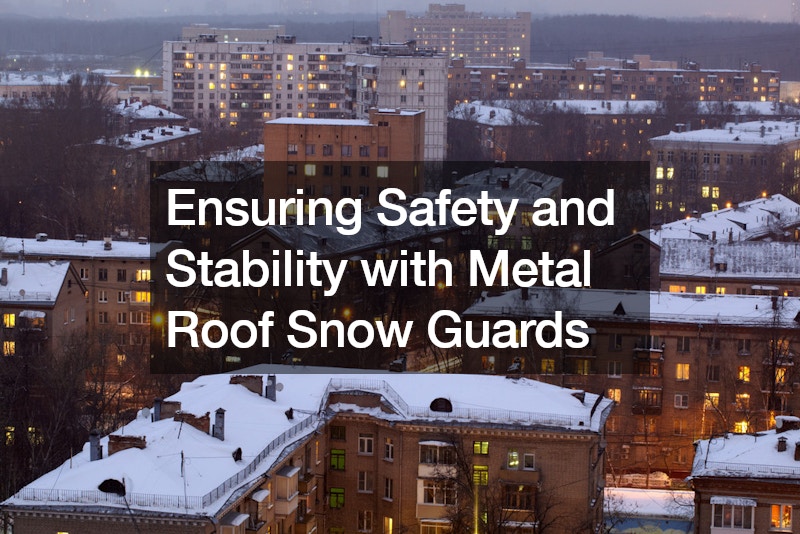

Metal roofing is renowned for its durability and resilience against various weather elements, from wind to hail. However, during winter months, the accumulation of snow and ice on metal roofs can pose significant safety hazards. Sudden snow and ice slides not only endanger individuals below but can also cause damage to property. To mitigate these risks and ensure the safety and stability of metal roof installations, the use of metal roof snow guards has become increasingly popular.
Metal roof snow guards, also known as snow stops or snow retention systems, are devices installed on metal roofs to prevent the sudden release of snow and ice.
These guards serve a crucial role in controlling the movement of snow and ice, allowing for gradual melting and runoff rather than abrupt avalanches.
One of the primary concerns with metal roofs during winter is the phenomenon known as “roof avalanching.” After a snowfall, when sunlight or warmer temperatures cause the snow and ice on the roof to melt, large sheets of snow and ice can suddenly slide off the roof, posing a danger to anyone below. This poses a particular risk in areas where pedestrian traffic or parked vehicles are present.
Metal roof snow guards are designed to address this issue by impeding the movement of snow and ice. By strategically placing snow guards along the roof’s surface, contractors can create barriers that break up snow and ice accumulation, preventing it from sliding off in large, potentially hazardous chunks. Instead, snow guards encourage snow and ice to gradually melt and runoff, reducing the risk of sudden avalanches.
There are various types of metal roof snow guards available, including pad-style snow guards, fence-style snow guards, and seam-mounted snow guards. Each type is designed to suit different roof profiles and snow load conditions. Pad-style snow guards typically feature flat or curved surfaces that help distribute the weight of snow and ice, while fence-style snow guards consist of vertical rods or bars that create barriers to prevent sliding.
The installation of metal roof snow guards requires careful consideration of factors such as roof pitch, snow load, and local weather conditions. Proper placement and spacing of snow guards are essential to ensure effective snow retention without compromising the roof’s structural integrity. Contractors must also adhere to manufacturer guidelines and industry standards to achieve optimal performance and durability.
In addition to their practical function, metal roof snow guards can also enhance the aesthetic appeal of a metal roof. With a wide range of styles and finishes available, snow guards can be customized to complement the roof’s design and architectural features. Whether discreetly integrated into the roof’s profile or prominently displayed as decorative elements, snow guards can add a distinctive touch to metal roof installations.
Despite their effectiveness in preventing snow and ice slides, metal roof snow guards are not without challenges. In some cases, improperly installed or inadequate snow guards may fail to adequately control snow and ice accumulation, leading to potential safety hazards. Additionally, snow guards may require periodic maintenance to ensure they remain secure and functional, particularly in regions with heavy snowfall or extreme weather conditions.
Metal roof snow guards not only provide practical benefits but also contribute to environmental sustainability. By controlling the release of snow and ice, snow guards help prevent excessive runoff, which can contribute to erosion, flooding, and water pollution. Additionally, by promoting gradual melting and runoff, snow guards can help conserve water resources by allowing melted snow to replenish groundwater supplies.
Furthermore, metal roof snow guards can enhance energy efficiency by reducing the formation of ice dams. Ice dams occur when melted snow refreezes at the roof’s edge, creating barriers that prevent proper drainage and potentially leading to water damage and heat loss. By preventing snow and ice from accumulating and melting unevenly, snow guards help minimize the risk of ice dam formation, thereby improving the roof’s overall thermal performance and reducing heating costs.
Incorporating metal roof snow guards into roofing designs not only ensures safety and stability but also aligns with sustainable building practices. By mitigating the risks associated with snow and ice accumulation, snow guards contribute to the longevity and performance of metal roof systems while minimizing their environmental impact. As such, the adoption of metal roof snow guards represents a proactive approach to enhancing both safety and sustainability in roofing construction.
In conclusion, metal roof snow guards play a crucial role in ensuring the safety and stability of metal roof installations during winter months. By effectively controlling snow and ice accumulation, snow guards help prevent sudden avalanches and reduce the risk of property damage and personal injury. With proper selection, installation, and maintenance, metal roof snow guards offer a practical and visually appealing solution for managing snow and ice on metal roofs.
.


